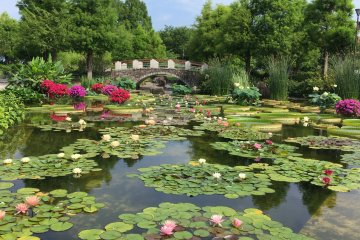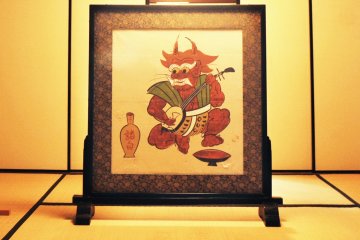
Water Lily Exhibition 2026
Kim BergströmShiga's Mizunomori Water Botanical Garden is home to over 150 types of water lilies, and they typically begin to bloom in early June. An annual exhibition of flowers is held to coincide with this.

Also known as Kusatsu Aquatic Botanical Garden, the Mizu-no-Mori Water Botanical Garden is a wonder for flora enthusiasts. Located in Shiga Prefecture on the southeastern shore of Lake Biwa, this botanical garden specialized in aquatic plants and is especially renowned for its lotus displays. Mizu-no-Mori means “water forest” and it’s easy to see why this treasure trove of plants invokes curiosity and glee from visitors.
A great place for families or couples, or even the solo plant lover, Mizu-no-Mori provides shifting scenery against the backdrop of the Hira and Hieizan mountains alongside Lake Biwa. To fully enjoy your time at the garden, set aside enough time to see their many areas (at least one hour is recommended).
Wander through herbal gardens, wet flower gardens, mountain-path foliage, and over lily ponds that are reminiscent of a Monet painting. No visit is the same as the exhibits change and grow seasonally. From flowers to aquatic plants—and the unique Lotus Pavilion—a trip to Mizu-no-Mori Water Botanical Garden provides a beautiful learning experience.
Lotus and water lily can be found collected in this centrally-located pavilion in the garden. The atrium houses domestic and foreign aquatic plants, water lilies, and lotuses. There are also other great exhibits in the Lotus Pavilion, such as murals, a video theater, an art gallery, and even a restaurant where you can grab a bite to eat—be sure to try the lotus-flavored soft serve ice cream or udon made by kneading lotus leaves into noodles.
Enjoy the cool air surrounding this symbolic fountain in Mizu-no-Mori. Representing the bonds between water and people, this fountain often hosts water displays. The surrounding flowers—both hanging and flowerbeds—are changed every season. Look forward to seeing the fountain change with time.
Take the bus bound for Lake Biwa Art Museum at Kusatsu Station and get off at the Mizu-no-Mori stop. It takes about 25 minutes.

Shiga's Mizunomori Water Botanical Garden is home to over 150 types of water lilies, and they typically begin to bloom in early June. An annual exhibition of flowers is held to coincide with this.

Men-ya Lennon has excellent ramen just a few minutes walk from JR Otsu Station.

Enryaku-ji Temple, located on Mount Hiei in Otsu, overlooks all of Kyoto from its serene mountaintop. The temple was founded in 788 in the early Heian period by Saicho, who brought the Tendai sect of Buddhism from China to Japan. He is one of the most important monasteries in Japanese history. At its peak, the Enryaku-ji Temple had up to 3,000 sub-temples and a powerful army of martial monks, who often got involved in power struggles with other monasteries and political leaders. Oda Nobunaga attacked, demolished and killed most of Enryakui's buildings in 1571 in order to eliminate all potential rivals and unite the country. Hence, most of today's temple buildings date from the early Edo period when the Enryaku-ji Temple was rebuilt.

The Moomins are characters in a cartoon series developed by Finnish illustrator Tove Jansson, and they've become quite popular here in Japan. A special event at Shiga's Sagawa Art Museum looks at over 280 drawings and sketches of this much-loved troll family.
